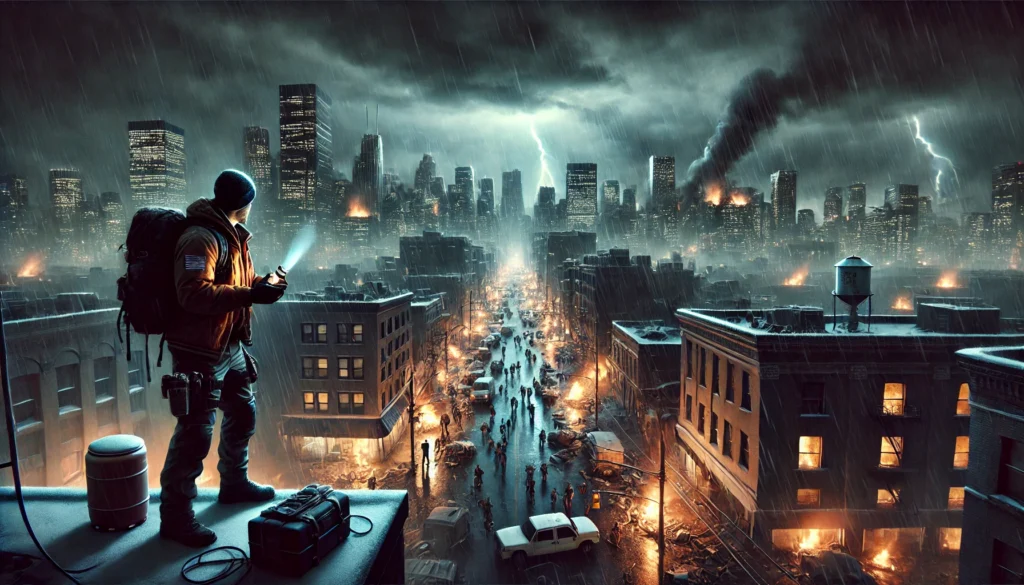

Introduction
The U.S. power grid is one of the most complex and essential systems in the country. It supports hospitals, financial institutions, food production, and virtually every aspect of modern life. But what would happen if it suddenly went down—nationwide—for an extended period?
Whether due to a cyberattack, EMP (electromagnetic pulse), extreme weather, or aging infrastructure, a prolonged power grid failure would be catastrophic. In this article, we’ll break down the first 30 days of such a crisis, explain how to protect yourself, and provide a list of essential preparedness items you can buy today.
What Happens When the Grid Goes Down?
Day 1–3: Immediate Chaos
- Power Outages Begin – At first, people assume it’s a temporary blackout. Phones may work briefly, but cellular networks start failing as backup generators run out of fuel.
- Traffic and Transportation Halt – Streetlights stop working, leading to accidents and congestion. Gas stations without generators can’t pump fuel.
- Water Systems Begin to Fail – Municipal water plants stop running. Without electricity, most homes lose water pressure.
- Emergency Services Overwhelmed – Police, firefighters, and hospitals face surges in demand. Looting begins in some areas as people realize stores won’t restock anytime soon.
Day 4–7: Panic Sets In
- Grocery Stores Empty – Panic buying depletes shelves. Without refrigeration, perishable foods spoil.
- Communications Collapse – TV and radio stations shut down. The internet becomes unreliable.
- Mass Exodus from Cities – People flee urban areas in search of resources, leading to stranded vehicles and violent encounters.
Day 8–14: Societal Breakdown
- Law Enforcement Fails – Officers prioritize their families, leaving communities defenseless.
- Diseases Spread – Without sanitation, waste accumulates. Lack of clean water causes outbreaks.
- Martial Law or Local Governments Step In – Some areas may see military intervention, but large regions remain lawless.
Day 15–30: Survival Mode
- Starvation and Violence Increase – Those without food supplies become desperate.
- Black Markets Rise – People trade goods for survival. Firearms, food, and fuel become currency.
- Off-Grid Communities Form – Those who prepared start to band together, faring better than unprepared city dwellers.
How to Protect Yourself
1. Secure a Water Source
- Store at least 30 days’ worth of bottled water (one gallon per person per day).
- Invest in high-quality water filters (e.g., LifeStraw, Berkey).
- Learn how to collect and purify rainwater.
2. Stockpile Non-Perishable Food
- Buy bulk items like rice, beans, canned goods, and freeze-dried meals.
- Store cooking fuel (propane, butane, firewood) and manual cooking tools.
3. Have Backup Power Solutions
- Solar generators and portable power stations can keep essential devices running.
- Rechargeable battery packs and hand-crank radios provide emergency communication.
4. Protect Your Home
- Reinforce doors and windows.
- Have a reliable self-defense plan (firearms, pepper spray, alarms).
5. Medical Preparedness
- Stock up on first aid kits, prescription medications, and over-the-counter essentials.
- Learn basic medical skills for emergencies.
6. Alternative Communication Methods
- Walkie-talkies and HAM radios can keep you connected.
- Have printed maps and pre-planned meeting spots.
7. Self-Sufficiency Skills
- Learn how to grow food, hunt, and forage.
- Gain knowledge in off-grid living (fire-starting, shelter building, etc.).
Essential Amazon Survival Products
- Water Filtration:
- Long-Term Food Storage:
- Portable Solar Generator:
- First Aid Kit:
- Emergency Radio:
- LED Lanterns:
- Self-Defense:
- Fire Starter Kit:
- Survival Knife:
- Off-Grid Cooking:
Final Thoughts
A U.S. power grid failure isn’t just a doomsday fantasy—it’s a real possibility. The best way to protect yourself and your loved ones is through preparation. Start today by securing essential supplies, learning survival skills, and forming a plan with your community.
Don’t wait until it’s too late—start preparing now.










